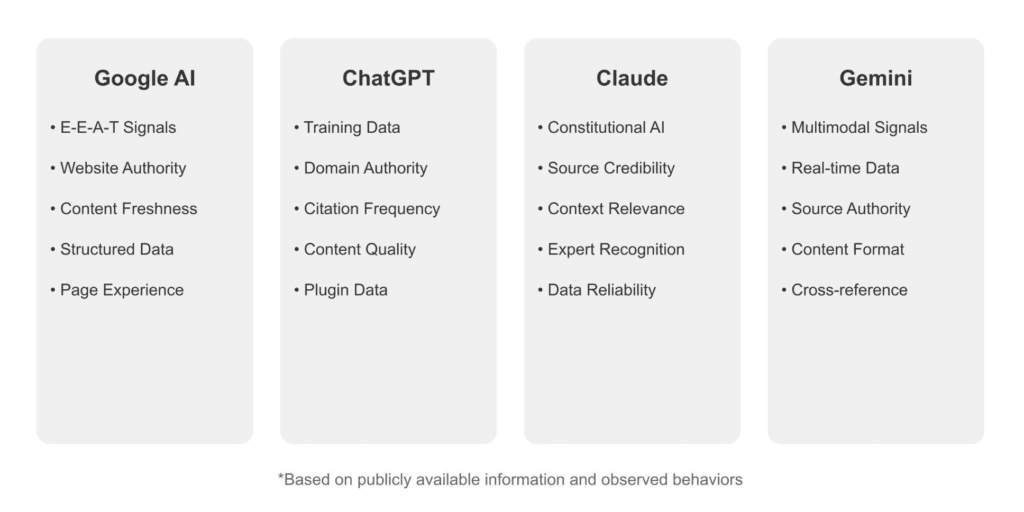Search is changing. Generative AI is rewriting the rules of how content is discovered and accessed online.
Digital marketers, SEO professionals, and content creators—this means rethinking your entire optimization strategy, and here’s why:
- Google’s AI search (SGE) appears in over 90% of popular search queries, and research suggests 42% of consumers prefer those AI-generated search results over traditional listings.
- By 2028, Gartner predicts brands will lose 50% of their organic search traffic to AI-powered search
Traditional SEO alone is no longer enough. Your content needs to be optimized not just for search engine rankings, but for AI systems that analyze, evaluate, and cite your content as authoritative sources.

Large Language Model Optimization (LLMO) is emerging as the critical skill set for maintaining and improving content visibility in 2025. If you’re responsible for your business’s digital presence, you need to understand how to optimize content for both search engines and AI models.
This guide breaks down what LLMO is and exactly what you need to do to implement it.
What is Large Language Model Optimization (LLMO)?
Large Language Models (LLMs) are AI systems trained on massive amounts of text data–think ChatGPT, Google’s Gemini, or Claude.
While traditional SEO focuses on helping search engines understand your content and ranking it in search results, LLM optimization means ensuring your content is processed and cited by AI systems and is used as answers to people’s queries.
LLMO matters because people are changing how they find information. Instead of scrolling through search results, users now prefer to get direct answers or summaries generated by AI. These answers are created by combining information from multiple sources. Your goal with LLMO is to make your content one of those trusted sources for the AI models.
Here’s an example:
Let’s say someone searches for “Best CRM Software for 2025”
Traditional SEO Approach: Creates content optimized for search rankings
- Title: “Best CRM Software 2025: Top 10 Solutions Compared”
- Focuses on keywords like “CRM software,” “best CRM,” “CRM comparison”
- Structures content around ranking factors and search visibility
LLMO Approach: Creates content optimized for AI understanding and citation
- Title: “How to Choose the Right CRM Software: A Complete Analysis”
- Focuses on answering specific questions like:
- “Which CRM is best for a small marketing agency with 10 employees?”
- “What features should I look for in a CRM if I run a B2B software company?”
- “How do different CRMs handle automation for e-commerce businesses?”
- Provides context and detailed comparisons that AI can cite
LLMO vs. Traditional SEO: Key Differences
The key difference? Search engines look for specific signals like keywords and backlinks. AI models, however, try to understand your content more like a human would–they grasp context, evaluate authority, and look for clear, direct answers to questions. Here are the major differences between these two content optimization strategies.
| Aspect | Traditional SEO | LLMO |
| Primary goal | Rank higher in search results page | Be cited as an authoritative source in AI-generated answers |
| Content gocus | Keyword optimization and placement | Natural language answers and comprehensive context |
| Success metrics | Rankings, traffic, clicks, time on page | Citation frequency, answer inclusion, content authority |
| Content structure | Keyword-rich headlines, meta descriptions, alt text | Question-answer format, clear context markers, structured data |
| User intent | Match keywords to search queries | Understand and answer underlying questions |
| Link building | Focus on quantity and authority of backlinks | Emphasis on contextual references and citations |
| Content length | Often prioritizes longer content for ranking | Values concise, direct answers with supporting context |
| Technical focus | Site speed, mobile optimization, XML sitemaps | Structured data, semantic HTML, clear content hierarchy |
The Three Pillars of LLMO
LLMO stands on three main pillars that work together to make your content perform well in both AI and traditional search.

Let’s break down each one:
1. Natural Language Content Design
Think of this as writing for humans first, AI second. It means:
- Creating content that flows naturally like a real conversation
- Answering questions directly and completely
- Using clear, everyday language instead of stuffing keywords
- Structuring content around actual questions people ask
Real-world example: Instead of a web page titled “Enterprise Cloud Solutions,” you might create one that answers “How do enterprise cloud solutions help reduce IT costs?” and then provide comprehensive, natural explanations.
2. Context-Rich Information Architecture
This is about helping AI understand the bigger picture of your content. It involves:
- Connecting related topics and ideas clearly
- Providing supporting evidence and examples
- Creating content clusters that cover topics thoroughly
- Including relevant details that help AI models understand the full context
Real-world example: When writing about a product, don’t just list features. Include use cases, industry scenarios, customer challenges, and how the features solve specific problems.
3. Credibility Signals
This helps AI models determine if your content is trustworthy and citation-worthy:
- Backing claims with data and sources
- Showing real expertise through detailed explanations
- Maintaining up-to-date, accurate information
- Including author expertise and credentials when relevant
- Using structured data to clarify your authority on topics
Real-world example: Instead of just saying “our software improves productivity,” provide specific data like “customers report saving an average of 15 hours per week based on our 2024 user survey of 500 companies.”
What about technical optimization?
While the three pillars above are specific to LLMO, you might be wondering: “What happened to technical optimization?” Technical optimization is still the foundation everything else sits on. It’s a critical requirement for both traditional SEO and LLMO. The difference is that while technical optimization helps search engines find and understand your content, LLMO’s pillars help AI models interpret, evaluate, and cite it. It includes:
- Clean HTML structure
- Schema markup
- XML sitemaps
- Mobile responsiveness
- Fast loading times
- Proper meta tags
How Major AI Systems Rank And Source Results
Understanding how AI models choose their sources can help you create content that’s more likely to be cited in AI-generated answers. Here’s a look at what major AI systems prioritize when selecting sources:

When Google’s AI (including SGE) generates an answer, it strongly favors content that demonstrates real expertise rather than just keyword optimization. For example, if someone asks about “best practices for email marketing,” it’s more likely to cite content that includes case studies, specific data points, and expert insights rather than a generic list of tips.
ChatGPT tends to prioritize comprehensive, well-structured content that directly answers specific questions. It looks for sources that provide clear, authoritative information and are frequently cited across the web. For instance, when asked about “how to launch a startup,” it typically pulls from content that breaks down complex processes into clear steps and backs claims with industry examples.
Claude is particularly interested in content that shows its work – meaning it values sources that explain reasoning and provide evidence for claims. If someone asks about “investment strategies,” it’s more likely to cite content that explains the logic behind recommendations and includes relevant market data.
What does this mean for your content strategy?
The above shift in content ranking and evaluation have practical implications for marketers. It means:
- Lists and surface-level content are less likely to be cited
- Detailed explanations with supporting evidence rank better
- Content that answers specific questions directly performs well
- Sources that provide context and nuance are preferred
- Original insights and data are valued over aggregated content
Recommendations For Businesses (Marketers, Creators, SEO Pro’s)
AI models are looking for content that truly helps users understand a topic, not just content that’s optimized for search engines. Here are some new approaches for different roles:
For marketers, it’s not enough to just do basic keyword research anymore. You need to really dig into the questions your audience is asking and create content that covers topics from all angles. What can you do?
- Create content clusters that cover topics comprehensively
- Focus on building authority through original research and data
- Track citations in AI responses, not just search rankings
- Use structured data to help AI models understand your content better
Example: Say, you’re marketing a new project management tool, don’t just target broad keywords like “project management software.”
Instead, create content clusters around specific questions like “What are the best project management tools for remote teams?” or “How can AI-powered project management software improve efficiency?”
Conduct a survey of 500 remote teams to gather original data on their software preferences and pain points, and use that data to inform your content strategy.
Content creators, your job is to write in a way that sounds natural and conversational while directly answering the questions people are asking.
- Whenever you make a claim, try to include examples or evidence to support it
- Show off your practical expertise, not just abstract theories
- When you structure your content, use clear headings that follow natural questioning patterns
- Focus on depth over breadth in topic coverage
Example: When writing a guide on “How to choose the best email marketing software for e-commerce,” don’t just list generic features like “easy to use” or “affordable.”
Instead, get specific with real-world examples: “If you’re an e-commerce business that relies heavily on automated abandon cart emails, you’ll need a tool with advanced segmentation and personalization features. For example, Brand X used Software Y’s dynamic content feature to increase abandon cart email revenue by 30%.”
Structure your content with clear headings like “What email marketing features are essential for an year old e-commerce business?” or “How to evaluate an email marketing tool’s ROI on a budget of $50 per month.”
As for SEO professionals, it’s time to expand your optimization strategy to include both traditional SEO and LLMO principles.
- Implement schema markup to help AI models understand context of your content
- Focus on topic authority rather than just keyword density
- Create content hierarchies that show how topics are related
- Monitor both search rankings and how frequently you’re being cited by AI
Example: Imagine you’re optimizing a website for a law firm that specializes in personal injury cases.
Use schema markup to clarify the relationships between topics like “Car Accident Injuries,” “Medical Malpractice,” and “Wrongful Death.”
Create a content hierarchy that shows how a blog post on “What to Do After a Motorcycle Accident” that relates to the main practice area of “Motor Vehicle Accidents.”
Monitor not just the firm’s search rankings for keywords like “motorcycle accident lawyer,” but also track how frequently the site is cited in AI-generated answers to questions like “Do I need a lawyer after a motorcycle accident?” or “What are the most common injuries from motorcycle accidents?” Some SEO tools are beginning to offer features that specifically track AI citations, you can use them.
Quick LLMO Audit Checklist
- Does your content serve as a problem-solving tool rather than just information? (Buyer enablement)
- Are you answering specific questions your audience is asking? (Answer-optimized content or AOC)
- Is your content written in natural, conversational language rather than SEO-optimized phrases?
- Do you provide comprehensive context around your answers?
- Are your claims supported by evidence, data, or expert insights?
- Is your content structured to be easily understood by both humans and AI?
- Are you creating original insights rather than aggregating existing information?
- Is your content regularly updated to maintain freshness and accuracy?
The bottom line? It’s a shift in mindset, but starting with these fundamentals can help you stay ahead of the curve as AI reshapes the search landscape.
Related: Top 10 AI Leaders To Follow in 2025




